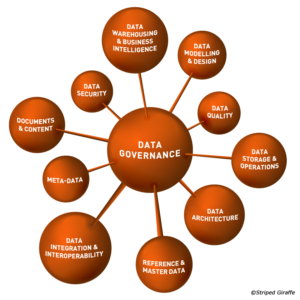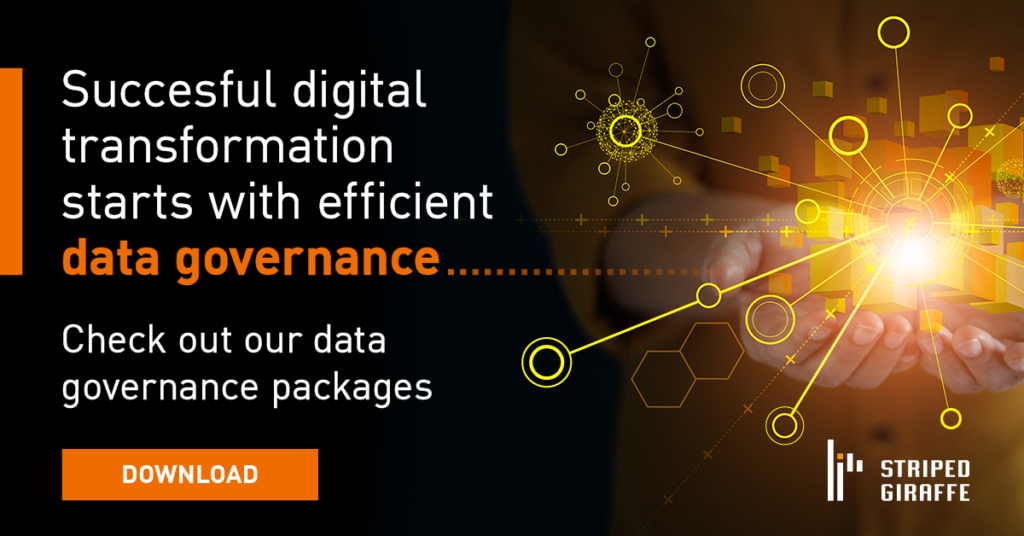
Data governance – the linchpin of efficient data management
Companies that want to set up their data management properly in order to make efficient use of one of their most valuable assets – their data – need professional data governance. You can’t do it without it. It is the holistic management of data throughout their entire lifecycle in an organization.
What is data governance?
It comprises processes, responsibilities, and rules for handling data within an organization. The first thing it does is define the responsibilities, guidelines, and standards that will be used in a company’s data management. Thus, data governance forms the heart of data management.
DATA GOVERNANCE IS A SET OF STRATEGIC ACTIVITIES THAT DEFINES THE ROLES, RULES, PROCESSES, AND BEST PRACTICES FOR THE COMPANY, TO ENSURE THE QUALITY, SECURITY, AND PROPER USE OF DATA.
Through 2025, 80% of organizations seeking to scale digital business will fail because they do not take a modern approach to data and analytics governance.
Andrew White, VP Analyst at Gartner
At its core, data governance is about optimizing all data for their different purposes and defining efficient end-to-end processes for data – be it for reliable forecasting, e-commerce, customer information, or any number of other purposes. All employees in an organization should be able to work with data, in order to become more productive and efficient. In companies without data governance, this right is usually reserved only for data scientists.
Data governance is not a one-off activity. Managing information requires a continuous program to ensure that the organization gets additional value from its data. It is very important that data governance follows the existing corporate policies and standards.
Findings from the BARC Trend Monitor
According to the survey results of the BARC Trend Monitor, data governance has been gaining more and more attention in the last two years. Looking at the study in more detail, it becomes evident that in particular, IT departments see the importance of data governance.
In an international comparison, it is very interesting to see that companies from the DACH region consider data governance to be far less important than the rest of Europe, North America, and Asia. The same applies to how they view the transformation into a data-driven culture. And that although data governance is becoming increasingly important, as data, organization, and technologies become ever more complex.
It all starts with the data governance framework
Ideally, data governance begins with the creation of a framework that consists of a set of rules, tools, and best practices that help ensure high quality throughout the enterprise data lifecycle. It is a function that supports an organization’s overarching data management strategy. A data governance framework encompasses the holistic capture, storage, processing, and the entire lifecycle of the data, including keeping them secure. Auditors in particular pay close attention to this, especially when it comes to highly sensitive data such as personal information.
Regulating responsibilities
It is also crucial that this framework includes all responsibilities. To this end, it is a good idea to create a RACI matrix (Responsible, Accountable, Consulted, Informed) at the outset, which provides an overview of the various roles and the expectations attached to them.
All authorized employees can view these roles, including the related responsibilities, and thus quickly find the right contact person or data owner. Authorization management is also part of data governance.
Start small then scale up
Today, data governance initiatives are developed in an iterative approach. This involves trying to adopt as many existing systems and processes as reasonable. To start off with, it is a good idea for organizations to keep the amount of data they include in a governance program small, and to then gradually scale up.
This approach allows processes to be optimized flexibly on a small scale, lessons learned to be implemented quickly for the next stage, systems to be deployed efficiently, and unnecessary costs to be avoided as a result. The following step-by-step plan is recommended for this purpose:
- Designate a data governance manager
- Select the initial data, systems, and participants
- Define goals
- Identify desired outcomes and obstacles to them
- Search for appropriate platform and suitable partners
- Define the optimal processes
- Scale the data governance step by step
As is so often the case, communication between the data governance manager and all stakeholders is critical throughout the entire process.
Data governance principles
The Data Governance Institute has established 8 principles to help stakeholders resolve the data-related conflicts that often arise in organizations.
- Integrity
All stakeholders must have integrity in dealing with each other. They must be open and honest when discussing the factors, constraints, options, and implications of data-related decisions. - Transparency
Data governance and stewardship processes require transparency. It must be clear to all stakeholders and auditors how and when data-related decisions and controls were introduced into the processes. - Traceability
Data-related decisions, processes, and controls that are subject to data governance must be auditable. They must be accompanied by documentation to meet the needs of compliance and company audits. - Accountability
You must define who is accountable for cross-functional data-related decisions, processes, and controls. - Stewardship
You have to define who is accountable for stewardship activities that fall within the scope of responsibility of individual employees and groups of data stewards. - Checks and balances
The programs must define responsibilities in a way that creates a system of checks and balances between the business and technology teams. This applies equally to those who create/capture data, those who manage it, those who use it, and those who implement the standards and compliance requirements. - Standardization
The program must introduce and support the standardization of enterprise data. - Change management
Programs must support proactive and reactive change management for reference data and for the structure/use of master data and metadata.
Goals of data governance
In the final assessment, data governance is about establishing methods, processes, and responsibilities in a company to standardize, integrate, protect and store the data there. It can be used to support a number of corporate goals, such as implementing compliance requirements, facilitating administration, and reducing costs. Organizations can become more agile and scalable with data governance. In addition, having the opportunity to reuse processes and data can significantly increase efficiency.
Conclusion
Data governance, while very complex, is essential to the use and management of your data. Don’t worry, we will not leave you to deal with it alone. Our data experts know what it takes and can help you with your project – no matter how extensive. Contact us at experts@striped-giraffe.com.



